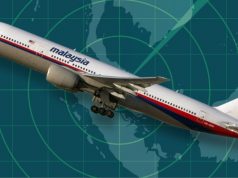

The “white and square” objects were spotted by crew of a Chinese Ilyushin-76 plane searching for the Malaysia Airlines Flight MH370 – that went missing on March 8 with 239 people on board – off Australia.
“The crew has reported the coordinates – 95.1113 degrees east and 42.5453 south – to the Australian command centre as well as Chinese icebreaker Xuelong, which is en route to the sea area,” reported state-run Xinhua news agency, whose reporters were on board.
According to Australian Maritime Safety Authority (AMSA), 10 aircraft were involved in Monday’s search for the MH370 which entered its fifth day.
“Two Chinese military aircraft departed about 8:45 am and 9:20am respectively. A RAAF P3 Orion departed for the search area just after 9am (local time),” it said in a statement.
Two ultra-long range civil jets, a second RAAF P3 Orion, a third ultra-long range jet, a US Navy P8 Poseidon aircraft, the two Japanese P3 Orion aircraft were also part of the search operations.
France yesterday provided new satellite images of possible debris of the airliner while in another possible lead, Australia said it has spotted a wooden cargo pallet in the southern Indian Ocean, expressing “increasing hope” of a breakthrough in locating the jet.
“The French sighting is I guess a piece of new material because that is in a completely different location. That is about 850 kilometres north of our current search area,” Australian Deputy Prime Minister Warren Truss said.
“So we need to check that out as well.”
However, he cautioned that it was yet “certain that the aircraft is even in this area”.
“We’re just, I guess, clutching at whatever little piece of information comes along to try and find a place where we might be able to concentrate the efforts,” Truss said.
The hunt for jet – that disappeared from radar screens an hour after taking off from Kuala Lumpur with 239 people on board, including five Indians, an Indo-Canadian and 154 Chinese nations – was intensified with India, China and Japan deploying surveillance aircraft on Sunday.
Truss, while talking to a radio channel here, admitted the search for the missing jet “is a very difficult task”.
The search area was very large and for today, it was around 68,000 square kilometres, he said, adding “so it’s a lot of water to look for just perhaps a tiny object”.
“The weather yesterday wasn’t too bad, although there was early morning fog. Today, we expect the weather to deteriorate and of course the forecasts ahead are not all that good. So, it’s going to be a challenge but we’ll stick at it,” he said.
Meanwhile, the US Pacific Command has ordered the Pacific Fleet to move a black box locator into the region where search for the missing jet is underway.
In a statement released on Sunday, the US Navy stressed that the deployment of the Towed Pinger Locator 25 (TPL-25), was only a “precautionary measure in case a debris field is located”.
According to the statement, if a debris field is confirmed, the locator “will add a significant advantage in locating the missing aircraft’s black box,” Xinhua reported.
The TPL-25 system is able to locate black boxes of downed aircraft “down to a maximum depth of 20,000 feet (6 km) anywhere in the world”, the statement said.









